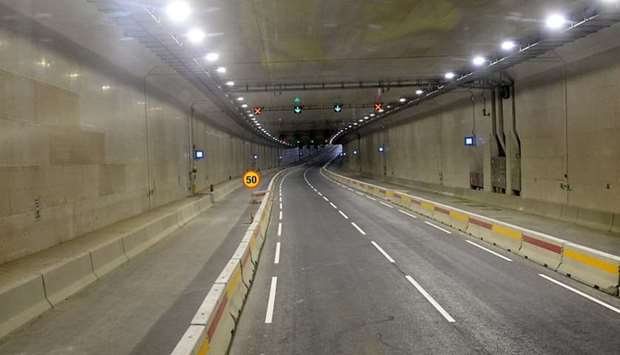The Public Works Authority (Ashghal) on Saturday opened Qatar’s longest and deepest bi-directional tunnel as part of the construction of the Al Rayyan Road Upgrade Project Phase 2.
The tunnel forms part of the newly-upgraded 2.1km stretch between Bu Erayen and Lebday Street, said Yousef al-Emadi, manager of Highway Projects Department, during a briefing held in the presence of Brigadier General Mohamed Maarafiya, manager of Ministry of Interior’s Traffic Safety Department, and a number of officials and project engineers.
The tunnel forms part of the newly-upgraded 2.1km stretch between Bu Erayen and Lebday Street, said Yousef al-Emadi, manager of Highway Projects Department, during a briefing held in the presence of Brigadier General Mohamed Maarafiya, manager of Ministry of Interior’s Traffic Safety Department, and a number of officials and project engineers.
The new tunnel is a major link between Bu Erayen and Lebday Streets, spanning the Al Mokafaha and Lebday Interchange. The tunnel is 1.5km long and sits 25m below ground level, making it the longest and deepest bi-directional tunnel in Qatar. At this initial stage, two of four lanes in each direction will be delivered, accommodating 8,000 vehicles per hour in each direction.
The tunnel forms part of the complex three-level Al Mokafaha interchange. At-grade (ground level) is a signallised junction, which facilitates traffic movements in all directions, including Al Waab, Bani Hajer and Doha.

The approach to the tunnel. PICTURE: Shaji Kayamkulam
Beneath this is an underpass that allows road users to travel seamlessly between Doha and Bani Hajer. The tunnel is beneath the underpass, both of which replace the old roundabout.
Project manager Jumah al-Bader noted that the newly-opened section of the road and tunnel will reduce travel time between Bu Erayen and Lebday Street and Al Luqta and Al Waab by up to 65%, because of increased lane capacity and removal of the existing diversions, and will reduce traffic congestion on 22 February Street.
Al-Bader said the construction of the new tunnel faced many challenges, which were all addressed. He said it was necessary to establish multiple traffic diversions and the construction of two temporary signallised intersections to facilitate the progress of works.
Excavating 25m below ground level meant that the project team had to manage extremely large quantities of groundwater, he said.
He explained that the tunnel is fitted with all the safety and security facilities and that a dedicated building was constructed to serve as the central control room for monitoring and controlling all operating system. This built-in system will allow the safe operation of the tunnel, according to al-Bader.
The opening of the tunnel follows another series of openings achieved by Ashghal towards the end of 2018. These include the partial opening of two new underpasses at the Al Mokafaha and Khalid Bin Abdullah Al Attiyah Interchange and the partial opening of a new bridge at Khalid Bin Abdullah Al Attiyah Interchange, as well as a new tunnel at Sheikh Khalid Bin Hamad Al Thani Interchange.
The tunnel forms part of the complex three-level Al Mokafaha interchange. At-grade (ground level) is a signallised junction, which facilitates traffic movements in all directions, including Al Waab, Bani Hajer and Doha.

The approach to the tunnel. PICTURE: Shaji Kayamkulam
Beneath this is an underpass that allows road users to travel seamlessly between Doha and Bani Hajer. The tunnel is beneath the underpass, both of which replace the old roundabout.
Project manager Jumah al-Bader noted that the newly-opened section of the road and tunnel will reduce travel time between Bu Erayen and Lebday Street and Al Luqta and Al Waab by up to 65%, because of increased lane capacity and removal of the existing diversions, and will reduce traffic congestion on 22 February Street.
Al-Bader said the construction of the new tunnel faced many challenges, which were all addressed. He said it was necessary to establish multiple traffic diversions and the construction of two temporary signallised intersections to facilitate the progress of works.
Excavating 25m below ground level meant that the project team had to manage extremely large quantities of groundwater, he said.
He explained that the tunnel is fitted with all the safety and security facilities and that a dedicated building was constructed to serve as the central control room for monitoring and controlling all operating system. This built-in system will allow the safe operation of the tunnel, according to al-Bader.
The opening of the tunnel follows another series of openings achieved by Ashghal towards the end of 2018. These include the partial opening of two new underpasses at the Al Mokafaha and Khalid Bin Abdullah Al Attiyah Interchange and the partial opening of a new bridge at Khalid Bin Abdullah Al Attiyah Interchange, as well as a new tunnel at Sheikh Khalid Bin Hamad Al Thani Interchange.


